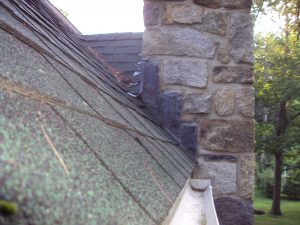Chimney Liners play an Important Role in Efficient Home Heating and Fire Protection
By Mark J. Donovan
|
|
Chimney liners play an important role in the operation of a chimney. A chimney liner helps to control the flow of soot and other combustible materials out of the chimney. It also severs as an insulator between the chimney walls themselves and the hot, acidic combustible materials that could damage or corrode the chimney. Chimney liners also work to produce the draft necessary for the furnace appliance (e.g. wood stove, fireplace, gas/oil furnace) to suck in air to enable the proper combustion of the fuel product (e.g. wood, gas, oil).
Chimney Liner Types Chimney liner types consist of clay ceramic tile liners, stainless steel or aluminum liners, and poured cement liners. |
Clay Ceramic Tile Chimney Liners
Clay ceramic tile chimney liners are the most popular because they are the least expensive, and are easy to install. However they are brittle and have a poor rate of expansion. As a result they can break or crack easily when they experience rapid temperature changes. If the liner becomes cracked then the chimney and home are at a high risk of becoming damaged due to the hot exhaust of combustible materials. Consequently if a chimney inspection indicates cracked chimney liner tiles the flue should be repaired immediately.
Poured Cement Chimney Liners
Poured cement chimney liners are also frequently used in the repair of cracked clay ceramic tile liners. Poured cement liners are installed by inserting a long air bladder into the existing chimney and then pouring a cement material around it. When the cement has hardened the bladder is deflated and removed. The result is a perfectly smooth, seamless cement chimney liner.
| Poured cement chimney liners have a couple of key advantages. First they are well insulated, due to the fact that they are made out of a cement product. Second, because they are a cement product they can help to had strength and rigidity to an older existing chimney. On the downside, they are more expensive to install due to the equipment required to get the concrete mixture up onto the roof and poured into the chimney.
To conclude, a chimney liner plays a vital role in efficiently burning fuel and protecting your chimney and home from becoming fire damaged. Thus it is imperative that a chimney liner be in proper working order. |
 |
Also, if the chimney liner becomes cracked or damaged talk to a professional about what replacement chimney liner type is right for your specific heating application. Chimney liner requirements will vary depending upon what type of heating appliance or appliances are connected to it.
For information on Restoring Baseboard Heating Element Covers, see the Restoring Baseboard Heating Element Covers eBook from HomeAdditionPlus.com. The Restoring Baseboard Heating Element Covers Ebook provides easy to understand, step-by-step instructions, on how to restore Baseboard Heating Element Covers so that they look new again. Pictures are included for every key step in the process.
For information on how to maximize a wood stove’s heating efficiency, see HomeAdditionPlus.com’s Installation of Hood over Wood Stove eBook.
Related Information
- Tips on Building a Stone Fireplace
- Fireplace Firebacks
- Why Purchasing a Wood Stove is a Smart Decision
Additional Heating and Cooling Resources from Amazon.com
 |
 |
Free Heating and Cooling Price Quotes with No Obligation!
Fill out our 3-5 minute quick and easy form, and receive a free price quote on heating & cooling from one of our pre-screened and licensed HVAC contractors. This process is free and there is no obligation to continue once you receive your heating & cooling price estimate.

